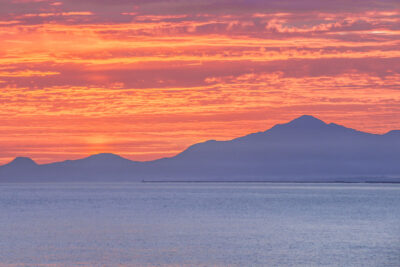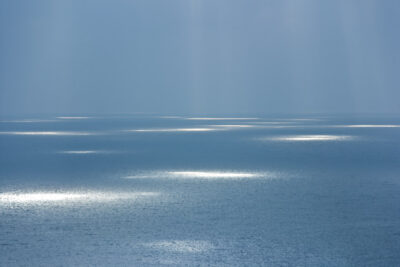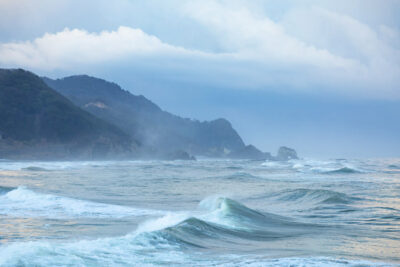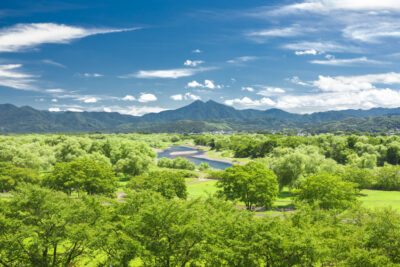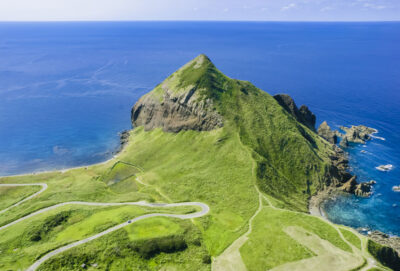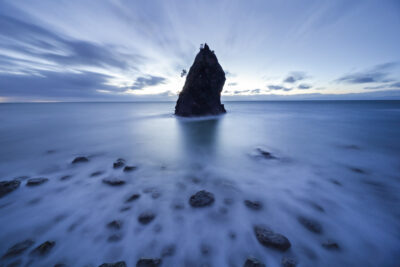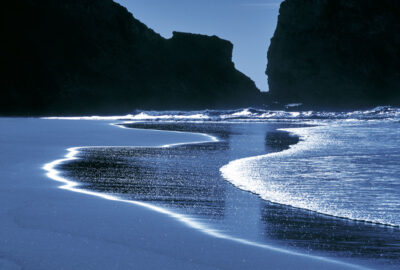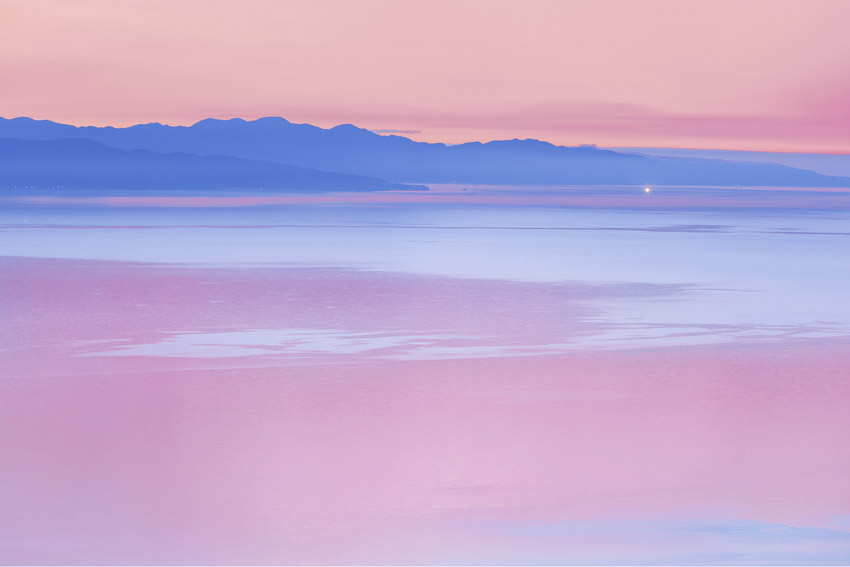
佐渡海峡
佐渡が最も近く見える場所といえば、やはり弥彦山からの眺めが格別です。新潟市の信濃川河口から佐渡両津港までは定期船で約60キロですが、弥彦山から佐渡島までは直線距離でおよそ35〜40キロと、ぐっと近く感じられます。7月の夕暮れ時には、両津湾の方向にイカ釣り船が集魚灯を灯し始め、海は穏やかで、夕焼けが水面に映る美しい光景が広がります。
日本の島の中で沖縄本島に次いで大きい佐渡島の面積は855㎢なので沖縄の1204㎢の7割ほどの大きさ。しかも大佐渡の最高峰金北山が1172メートル、小佐渡の最高峰大地山が646メートル。それに対して沖縄本島北部のヤンバル国立公園内の最高峰与那覇岳が503メートルなので単純な比較は難しいですが、佐渡は対岸から眺めてもボリューム感があります。しかし人口比で見ると沖縄本島の115万人に比べて佐渡の人口は4%の45,000人ほどなので、いかに人口密度が低いかお分かりになるかと思います。
そんな人口密度の低い佐渡にはさまざまな文化が受け継がれています。能や文弥人形、佐渡おけさなどの民謡、鬼太鼓やさまざまな田植え神事等々、日本の島の中でこれだけ多くの文化を今でも残している島は他にはないのではないでしょうか。現在でも移住する人たちはかなりの人数いらっしゃいますが、過去には北前船の寄港地として栄えた小木や金山、そして遠島の島として多くの文化人が配流となり、外からきた人たちによって文化的伝統のきっかけが作られたと言われています。工芸の分野では佐々木象堂をはじめ人間国宝も3名輩出しています。
私自身若い頃には、仕事で数えきれないくらい通った思い出の地でもあります。島人か旅人かは別として、船は旅を強く感じさせてくれるのかもしれません。船の旅を歌った歌詞は出てきませんが、森昌子の「哀しみ本線日本海」のフレーズように悲しさや孤独や人恋しさなど、少しセンチメンタルなイメージが北に向かう船にはあるのでしょうか。2010年に開催された「瀬戸内国際芸術祭」では、多島海の島々をむすぶ船にたくさん乗りましたが、かなり違う心境だったような気がします。この佐渡海峡を航行する新日本海フェリーにも幾度か乗船して北海道に行きましたが、大袈裟に言って大陸のような北海道に向かう大型客船の旅は外国に行くのとそれほど違いはないのかもしれません。
佐渡航路の感傷は、島がたどった歴史や、そこに暮らす人々の空気感から生まれるものかもしれません。実際佐渡を舞台にした小説はなぜか悲しい物語が多い。吉村昭や津村節子の小説は佐渡につきまとう雰囲気を敏感に嗅ぎとった小説家による創作の面もありますが、それぞれの出会いによってそれぞれのストーリーが出来上がり、それによってまた佐渡のイメージが広がり形作られるかもしれません。佐渡はなぜかあらゆるものが一つの雰囲気にまとまった大きなイメージを感じてしまう島なのです。それが「神秘」なのか「哀しみ」なのか「最果て」なのか・・・言葉にするのは難しいのですが、自然と歴史の中で醸成された偽りのない佐渡の「風土」ということなのでしょうか。
これからも私の佐渡ストーリーと印象を考えてゆきたいと思います。佐渡は近いようで遠い。手が届きそうでなかなか行けない場所にあることが佐渡を想像する上では良いのかもしれません。
When it comes to the best view of Sado Island, the view from Mount Yahiko is truly exceptional. While the distance from the mouth of the Shinano River in Niigata City to Sado Ryotsu Port is approximately 60 kilometers by regular ferry, the straight-line distance from Mount Yahiko to Sado Island is only about 35 to 40 kilometers, making it feel much closer. In the evenings of July, squid fishing boats begin to light their fishing lamps in the direction of Ryotsu Bay, and the sea is calm, with a beautiful scene of the sunset reflecting on the water.
Sado Island, the second-largest island in Japan after Okinawa Island, has an area of 855 square kilometers, which is about 70% the size of Okinawa’s 1,204 square kilometers. Moreover, the highest peak on O-Sado, Kinpoku-san, stands at 1,172 meters, while the highest peak on Ko-Sado, Daichi-san, reaches 646 meters. In comparison, the highest peak in the Yanbaru National Park on the northern part of Okinawa Island, Yonaha-dake, is 503 meters, so a direct comparison is difficult. However, Sado Island still feels substantial even when viewed from across the strait. However, when considering population density, Okinawa Island has 1.15 million people, while Sado has only 45,000 people, which is about 4% of Okinawa’s population. This illustrates how low the population density is on Sado.
Despite its low population density, Sado Island has preserved a variety of cultural traditions. Noh theater, Bun’ya dolls, folk songs like Sado Okesa, Ondeko drums, and various rice-planting rituals—there may be no other island in Japan that still preserves so many cultural traditions. While many people still move to Sado today, in the past, places like Komaki and Kanayama flourished as ports for Kitamae ships, and as an isolated island, many cultural figures were exiled there, with cultural traditions being established by people from outside. In the field of crafts, the island has produced three National Living Treasures, including Sasaki Syodo.
For me personally, it is a place I visited countless times for work in my youth. Whether one is an islander or a traveler, perhaps the ship itself evokes a strong sense of travel. While there are no lyrics specifically about ship travel, there is a sense of sadness, loneliness, and longing for others, reminiscent of the phrase “Sadness Main Line Japan Sea” from Mori Masako’s song, that seems to accompany ships heading north. During the 2010 Setouchi International Art Festival, I rode many ships connecting the islands of the archipelago, but I felt a significantly different mindset. I have also taken the New Japan Sea Ferry across the Sado Strait several times to travel to Hokkaido. To put it dramatically, the journey on a large passenger ship heading toward Hokkaido, which feels like a continent, may not be so different from traveling abroad.
The sentimentality of the Sado route may stem from the history the island has undergone and the atmosphere of the people who live there. In fact, novels set on Sado often tend to be sad stories. The novels of Yoshimura Akira and Tsukamoto Setsuko, while reflecting the atmosphere that clings to Sado, are also creations by writers who sensitively captured that atmosphere. Each encounter gives rise to a unique story, which in turn expands and shapes the image of Sado. Sado is an island where everything seems to come together into a single, cohesive atmosphere. Is it “mystery,” “sadness,” or “the farthest reaches”? It’s hard to put into words, but perhaps it’s the authentic “terroir” of Sado that has been cultivated through nature and history.
I would like to continue reflecting on my own stories and impressions of Sado. Sado is both close and far away. The fact that it feels within reach yet remains elusive may be what makes it so intriguing to imagine.
EOS5DMarkⅡ 170mm 10秒 f:8
©️photo by Nakamura Osamu
